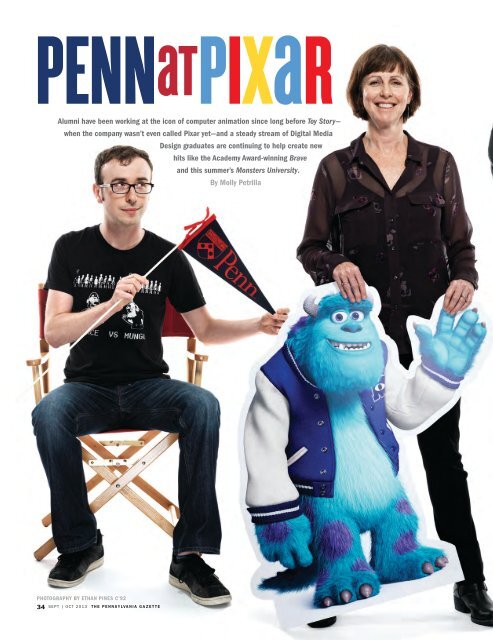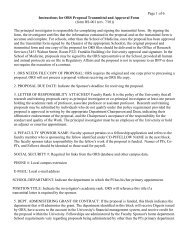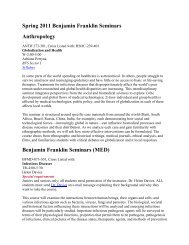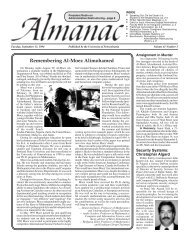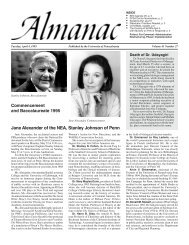Download this article (PDF) - University of Pennsylvania
Download this article (PDF) - University of Pennsylvania
Download this article (PDF) - University of Pennsylvania
Create successful ePaper yourself
Turn your PDF publications into a flip-book with our unique Google optimized e-Paper software.
PENNatPixarAlumni have been working at the icon <strong>of</strong> computer animation since long before Toy Story—when the company wasn’t even called Pixar yet—and a steady stream <strong>of</strong> Digital MediaDesign graduates are continuing to help create newhits like the Academy Award-winning Braveand <strong>this</strong> summer’s Monsters <strong>University</strong>.By Molly PetrillaPHOTOGRAPHY BY ETHAN PINES C’9234 SEPT | OCT 2013 THE PENNSYLVANIA GAZETTE
From left: Paul Kanyuk, Nicole Grindle,Ana Lacaze Jordan, David Bar<strong>of</strong>f, and Samantha Raja.THE PENNSYLVANIA GAZETTE SEPT | OCT 2013 35
producing sketch after sketch <strong>of</strong> MickeyMouse? There may be shades <strong>of</strong> that inthe Pixar art department, but a technicaldirector’s job relies on advanced technology,trading in colored pencils for powerfulcomputers.A technical director ideally has “astrong aesthetic vision but also knowsthe fundamental principles <strong>of</strong> computergraphics and how to do programming,”Raja says. She uses a physics-based computersimulation program to create andcontrol the way a character’s hair orclothes move. Once a director sees theInthe middle <strong>of</strong> Pixar’s sprawlingcampus in Emeryville, California,a 43-foot-tall desk lamp stands beside asuper-sized yellow ball with a red starand blue stripe.For anyone who’s seen a Pixar film, thetribute is obvious. The lamp appears atthe beginning <strong>of</strong> each movie, bouncingon a ball that suddenly bursts, then turningits lamp-shaded “head” to look sheepishlyinto the camera.But even before that, the lamp starredin the company’s first animation, LuxoJr.—a two-minute short from 1986 about“[Lasseter] had felt inspiration strikewhen Tom Porter [C’72] brought his infantson into work one day and Lasseter, playingwith the child, became fascinated byhis proportions. A baby’s head was hugecompared with the rest <strong>of</strong> its body,Lasseter realized. It struck Lasseter’sfunny bone and he began to wonder whata young lamp would look like. He fiddledwith the dimensions <strong>of</strong> all the parts <strong>of</strong>his Luxo model … and he emerged with asecond character, Luxo Jr.”Tom Porter has been at Pixar for so longthat he’s <strong>of</strong>ten asked to reminisce aboutits earliest days for books and documentariesabout the company. He arrived indefault simulation, he’ll <strong>of</strong>ten decide thatthings should look a little different andRaja will summon her computer scienceexpertise to start “playing with the parameters,”making a hair toss last longer ora patch <strong>of</strong> fur stand up straighter.As a technical director who helped animatehair and fur for Brave and Monsters<strong>University</strong>, Raja says her work feels important.At times, it’s almost felt too important.“In the beginning, I got really stressedout because I knew if I made a mistakeand no one caught it, it would be therefor millions <strong>of</strong> people to see and then itwould live on forever in the DVD,” shesays. “But I’ve sort <strong>of</strong> gotten over that.I’m okay with the pressure now.”a large “adult” lamp and a smaller,“young” one. The baby Luxo lamp is iconicat <strong>this</strong> point—enough <strong>of</strong> a mascot forPixar to justify the towering replica—andthe inspiration behind it has a Penn connection.John Lasseter, now the company’schief creative <strong>of</strong>ficer, came up with theidea one day thanks to an alumnusemployeeand his visiting baby. As DavidA. Price explains in The Pixar Touch:1981, more than a decade before BuzzLightyear flew or Nemo swam, and evenbefore the group was called Pixar. Backthen, it was the Computer GraphicsDivision at Lucasfilm, Star Wars creatorGeorge Lucas’s production studio.When Apple co-founder Steve Jobs boughtthe Lucasfilm <strong>of</strong>fshoot in 1986 and turnedit into an independent company, Porterbecame one <strong>of</strong> Pixar’s first 44 employees.THE PENNSYLVANIA GAZETTE SEPT | OCT 2013 37
“What Paul didn’t know at the time,”she adds, “is that they were working onCars, so reflective surfaces were reallyimportant to them.”When Kanyuk finished his first week asan intern, Calhoun got a phone call fromhis managers. “They said, ‘We gave himthese assignments thinking That’ll keepthe little tyke busy for a while, but he cameback at the end <strong>of</strong> his second day and he’ddone everything we gave him,’” Calhounrecalls. “I said, ‘I told you he’s smart!’”She suggested they put Kanyuk incharge <strong>of</strong> Pixar’s RenderMan phone supportline. “There was a huge backlog <strong>of</strong>questions,” she adds, “and Paul got rid<strong>of</strong> it in a week. Within two weeks, [Pixar]knew they wanted to hold on to <strong>this</strong> kid.He really changed everything for us.”By the end <strong>of</strong> his internship, Kanyuk hadan <strong>of</strong>fer from Pixar to return full-time aftergraduation and Calhoun was getting callsfrom the company asking if Penn had “anymore like Paul.” Though the DMD programwas seven years old at that point, Kanyukbecame its first graduate to land at Pixar.He’s been there ever since, first shadingchipped paint, rust, and dust for Cars, thenrendering crowd shots for Ratatouille,Wall-E, Up, Brave, and Monsters <strong>University</strong>.“Because [Pixar] had hired someonethey were happy with, we started to appearon their recruiting radar,” Badler says.The company began sending Kanyuk backto Penn once or twice a year to interviewother DMD students and tell them abou<strong>this</strong> work. “He knows the program, heON THE WEB | “Buzz Lightyear saved my life,”writes Alec Sokolow C’85, one <strong>of</strong> the screenwriterscredited for Toy Story, the beloved 1995 film that putPixar on the map and forever changed our expectations<strong>of</strong> animated films, spawned two smash-hitsequels and moved uncounted millions <strong>of</strong> relatedmerchandise, and created an iconic comic duo inspace-ranger Buzz and cowboy Woody.In “My Toy Story,” available only at our website,Sokolow tells how the news that he and his writingpartner had been hired to work on the film—thenlittle more than the concept “Two toys. One Boy” andthe title (which was “deemed uninspired,” but stuckanyway)—helped jolt him out <strong>of</strong> grief at his father’sdeath and sustained him through some <strong>of</strong> his darkestdays both personally and pr<strong>of</strong>essionally:“[W]hen all hope seemed lost and my very abilityto press on seemed to hang in the balance, BuzzLightyear somehow magically swooped in and rescuedme from the depths <strong>of</strong> personal loss. Threw me alifeline. Led me out <strong>of</strong> the darkness to the light. Tosafety and hope. To infinity and beyond.”Read more at www.upenn.edu/gazette.knows the school,” Badler adds. “He canbe an advocate for us as well as for Pixar.”Several recent graduates, includingSamantha Raja, had their first Pixar interviewwith the now-legendary Kanyuk.“Pretty much everyone [at Pixar] fromPenn, I recruited,” he says—a list thatincludes fellow technical directors MattKuruc EAS’08, Nancy Tsang EAS’09, ArielaNurko EAS’09, Emily Weihrich EAS’10,and Raja. Getting one or two students intoPixar every year is significant, Badler says,since the DMD major has only 20 or sostudents in a graduating class.Once the computer-animated gate intoPixar had been pried open, Calhoun realizedthat “I just have to get one [DMD student]in the door everywhere, and theneverything changes,” she says. In additionto Pixar, DMD alumni are currently workingat DreamWorks Animation, the gamecompany Zynga, The Walt Disney Company,Google, Facebook, Electronic Arts, andmore. As Karl Li puts it: “Pixar is not aone-hit wonder for DMD.”But it’s still the most sought-after wonder.“Pixar has a certain stature because <strong>of</strong> thesmall number <strong>of</strong> gems it produces and theparticular ways it pushes technology in interestingdirections,” Badler says. “I certainlythink it’s the premiere destination for ouralums, but not every DMD student wants towork in the motion-picture industry.”“I think what’s most interesting aboutPixar in comparison to any place I canthink <strong>of</strong> is that the awe lasts longer,”Calhoun adds. “The feeling that they reallyare making magic continues for a longtime. Our alumni are really proud <strong>of</strong> whatit is they’re creating. [They] are practicallyswirling around in a world <strong>of</strong> delight, like,Can you believe they pay us to do <strong>this</strong>?!”Nicole Grindle has been thinkingabout her Penn days a lot lately.She associate produced Monsters<strong>University</strong>, which chronicles the Monsters,Inc. characters’ college years. “We alwaysembrace the theme <strong>of</strong> the movie we’reworking on,” she says, and for Monsters<strong>University</strong> that meant a college sweatshirtday, a special-issue Frisbee to toss around,and even an employee yearbook.“For me, there’s an emotional resonance,”she says <strong>of</strong> the film. “There’s that feeling<strong>of</strong> striving so hard and wanting so badlyto figure out that you’re good at things.That’s what really resonates for me.”When Grindle left the bioengineeringmajor at the end <strong>of</strong> her freshman year, “Ifelt like such a failure at first,” she says.But then she found Bloomers. She joinedthe all-women musical and sketch comedygroup her junior year and was soonasked to direct the next spring show.“I was terrified,” she recalls. “I thinkmy stomach hurt for the entire year afterthat.” Still, in the spring <strong>of</strong> 1983, hername appeared under Director for theshow All Nonsense. It included a “BrokenFamily Feud” sketch with the cast <strong>of</strong>Kramer vs. Kramer battling the cast <strong>of</strong>Ordinary People—“including the deadson,” Grindle adds with a laugh.“It’s always really scary starting a newproject here,” she says <strong>of</strong> her current work.“But that fundamental experience at Penngave me faith that I could pull anything<strong>of</strong>f. Working with Bloomers probably contributedthe most to where I am today.”While Samantha Raja’s college daysended only a few years ago, she also findsfrequent reminders <strong>of</strong> Penn at Pixar. She’ssurrounded by other recent DMD alumsand, especially at the beginning, “it wasnice to have familiar faces,” she says. “Yousort <strong>of</strong> forget you went to Penn togetherbecause now Pixar is your commonground. But every so <strong>of</strong>ten you’ll say, ‘Hey,remember that thing that happened inPhiladelphia?’ and everyone does.”For Raja, Pixar is The Dream Job—theplace she fantasized about working sincewatching Ratatouille as a teenager. Twoyears in, she still takes the long way intowork every morning just to pass underthe giant Pixar sign.“I think that for an awful lot <strong>of</strong> studentswho come into computer graphics,the magic <strong>of</strong> the movies is the thing thatinspired them to study <strong>this</strong> in the firstplace and that motivated them throughthe really hard parts,” Calhoun says.“There are parts <strong>of</strong> the computer-sciencecurriculum that are just difficult. To besitting there in the computer lab at 2 a.m.on Hey Day when you know that all <strong>of</strong> yourfriends are out, there has to be somethingthat’s motivating you. For my students, themotivating factor is But someday I couldwork at Pixar. That was the thing theyalways wanted to do, and they believe thatby going through the DMD program they’llget it. And they usually do.”◆Molly Petrilla C’06 write frequently for the Gazetteand oversees the magazine’s arts&culture blog.THE PENNSYLVANIA GAZETTE SEPT | OCT 2013 39


